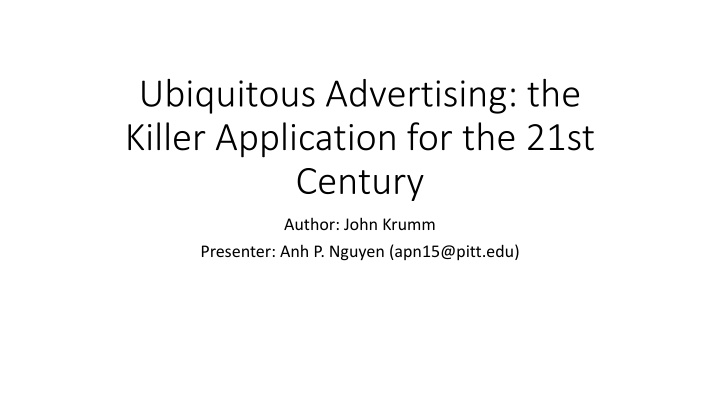
Ubiquitous Advertising: The Killer Application for the 21st Century
Explore the potential of ubiquitous advertising in the 21st century, from ad targeting to leveraging ubicomp technologies for targeted ads. Discover how mobile advertising is shaping the future, focusing on visit-pattern-aware systems for urban commercial complexes.
Download Presentation

Please find below an Image/Link to download the presentation.
The content on the website is provided AS IS for your information and personal use only. It may not be sold, licensed, or shared on other websites without obtaining consent from the author. If you encounter any issues during the download, it is possible that the publisher has removed the file from their server.
You are allowed to download the files provided on this website for personal or commercial use, subject to the condition that they are used lawfully. All files are the property of their respective owners.
The content on the website is provided AS IS for your information and personal use only. It may not be sold, licensed, or shared on other websites without obtaining consent from the author.
E N D
Presentation Transcript
Ubiquitous Advertising: the Killer Application for the 21st Century Author: John Krumm Presenter: Anh P. Nguyen (apn15@pitt.edu)
Introduction Advertising could be a Killer Application for ubiquitous computing. Many ubiquitous computing application will be supported by advertising as a continuation of the trend from internet sites. Ubiquitous computing techniques can help solve problems such as ad targeting and evaluating ads effectiveness.
Ad Targeting Segmenting and targeting Ad targeting helps advertisers reach intended customer/audience. Segmentation: divide customers into different groups based on traits such as demographics, psychographics, behavior. Example: age, user s browsing history.
Ad Targeting Targeting with Ubicomp Location sensing methods such as database of Wifi-access point and cell towers. Example: Skyhook Wireless, Acuity Mobile (location, time of dated). Looking ads that change accordingly to its current context Example: New York city buses, shopping carts with location sensors and digital display, billboards with radio sensor.
Ubicomp Tech for Targeted Ad more examples and possibilities Sense simple event at home to infer the activities. Infer traveler s mode of transportation based on GPS traces.
Ad-next: a Visit-Pattern-Aware Mobile Advertising System for Urban Commercial Complex Author: Byoungjip Kim et al. Presenter: Anh P. Nguyen (apn15@pitt.edu)
Introduction Mobile advertising is going to be application that brings profit in future. Commercial complexes such as COEX Mall has 260 stores and has hundred thousand visitor each days. Many of them go there to buy stuff. Problems: Advertising in big complex mall is important business. How to help user find a correct store. Two assumptions: Spatial relevant: if user is interested and there is relevant location nearby, user is likely to go there. Temporal relevant: if user is likely to purchase a product at a specific moment, a relevant ad at that moment will likely make user actually buy that product.
AdNext Predict users next visit place based on probabilistic prediction model.
AdNext design AdNext clients (mobile phone) - Collect place-in, place-out using Wi-fi fingerprint. - Notify user if an ad is available - Collect user behavior Advertising server -Build a prediction model - Send relevant ads based on prediction model - Collect the statistic
Collect Place Visit history Problem: Need to trace the place-in and place-out event (time, duration, location) Technique: Wifi localization A database of Wifi access point ID is stored. A collection of signal strength and AP ID is used to predict user current location. The duration of time user stop at a specific location is used to predict if user enter a store or just passing by.
Predicting the Next Visit Place Problems: Human behavior is uncertain by nature. Privacy problem: people do not like to be monitored. Idea: Visit causality Common visit pattern.
Select Relevant Ads Problem: Given a prediction result, there are many candidate ads. In COEX Mall, there are 60 placed classified as fashion shop, 50 places classified as restaurants. Mobile screen is small Two parameters: distance and rating c is user, pais place of ad a.
Evaluation A clean dataset of 76 people with 351 visits is collected. The data include place (P), visit time (T), visit duration (D), gender (G), age (A)
Evaluation CRF is conditional random field, a probabilistic prediction model
